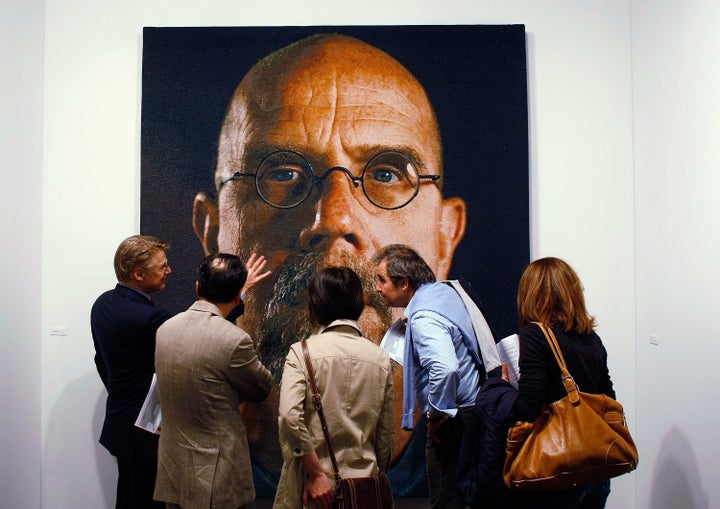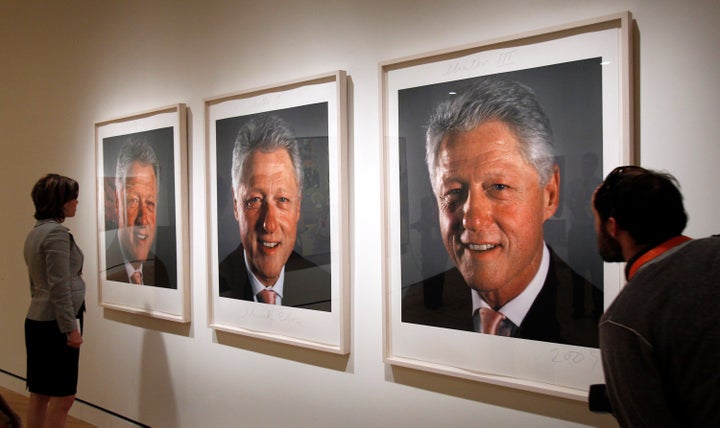
Chuck Close is one of the most celebrated and influential portrait artists alive today, widely known for his hyperrealistic images of faces both famous and not.
He’s also an alleged sexual harasser who’s been accused of misconduct by multiple women who say Close invited them to his studio to pose for him, coerced them into undressing, then humiliated them with sexual appeals.
Since HuffPost published the first round of allegations against Close in December, art institutions around the world have been grappling with a difficult question: How should they react to reports of sexual misconduct, particularly when those stories involve artists in their own collections?
As of now, eight women have accused Close of inappropriate sexual behavior, as reported by The New York Times and Hyperallergic. (Close called these claims “lies.”) Yet his work continues to inhabit museums including the Metropolitan Museum of Art in New York City, the Tate in London and the Centre Pompidou in Paris.
The question plaguing these institutions is not simply whether his work should stay or go. Rather, many in the art world are interested in how Close’s work can kickstart a conversation that addresses the systemic problems that influence so much of art history beyond any one artist.
Brooke Davis Anderson, director of the Pennsylvania Academy of the Fine Arts (PAFA) museum, said she met with a group of her senior officials the day after HuffPost’s article on Close was published. A traveling exhibition featuring 90 of Close’s photographs, organized by the Parrish Art Museum, is currently on view at PAFA, where it’s slated to stay until April.
The officials resolved to open their discussion to the broader school community, inviting faculty members, staff, students, curators, art historians and members of the public to participate in an open forum. Because winter break began shortly after the allegations against Close went public, Anderson delayed the forum until Jan. 17.
“We saw the whole spectrum of responses,” Anderson told HuffPost. “Some people felt the show should come down; others felt that that was the last thing we should do.”
The forum began with the question of what PAFA should do with Close’s work but expanded to address more sweeping concerns, including whether artists’ lives should influence interpretations of their art and whether art school traditions contribute to gendered power imbalances after graduation.
“We are a museum, but we also serve a school,” Anderson said, noting that PAFA is the first art school in the country. “We are home to 300 future artists,” and discussing and learning from the work of figurative artists like Close is fundamental to their education, she added.
Anderson and her senior team ultimately resolved to keep Close’s show up. But they opted to add a concurrent exhibition ― described as a “project space” or “charette” ― that will be displayed next door.
“I am convinced that if we took the show down, we would be cleaning our hands of the situation,” Anderson explained. “I felt keeping the exhibition open would ensure we face this conversation rather than conclude that we’ve dealt with it by taking the show down. This facilitates a difficult conversation.”
The “charette” gallery will feature works from PAFA’s permanent collection that Anderson hopes will catalyze conversations about power, gender, visibility and voice, though the museum has yet to finalize exactly which works to include. There will also be a 10-foot timeline, stretching from present day to 2050, to which museum-goers will be invited to contribute. Together, they will collectively imagine a future in which gender equality exists.
Moreover, the museum will provide visitors with prompts for further dialogue, such as: What myths have been enabled by power? Who has been given the power to speak? What have they said?
“Together we can start to make proposals and hatch a plan,” Anderson said. “The museum team felt strongly that we want to be proactive and think about tomorrow. We wanted to think through together, as women, what needs to happen.”

Anderson stressed that, although she firmly believes the addition of a second exhibition was the right choice for her institution, it isn’t necessarily the best for all.
Indeed, museums have diverged in terms of their responses to the allegations against Close. Some have opted to take down Close’s work from view. For example, Washington’s Seattle University removed “Self-Portrait 2000” from its prominent spot on the second floor of the Lemieux Library and replaced it with a painting by Linda Stojak. Members of the university’s administration explained their motivation in an email to The Stranger: “We were concerned about potential student, faculty or staff reaction to seeing the self-portrait, and decided that the prudent and proactive course of action would be to replace the self-portrait with another work.”
The National Gallery of Art in Washington, D.C., postponed an exhibition of Close’s work, scheduled for May. Anabeth Guthrie, chief of communications at the museum, wrote in an email to HuffPost that the museum began deliberating a course of action last year.
“All parties involved acknowledged that it is not the appropriate time to present these installations,” Guthrie said. “The decisions to postpone the installations were made soon after learning of the circumstances and consulting with the artists. We have not yet determined the special installations to present instead.”
However, the National Gallery will not remove “Fanny/Fingerpainting,” a 1985 portrait of Close’s grandmother-in-law on view in the East Building of the permanent collection.
The Metropolitan Museum of Art similarly has no intention of taking down Close’s works in their collection. As Sheena Wagstaff, chairman for modern and contemporary art at the Met, told The New York Times, “If we only see abuse when looking at a work of art, then we have created a reductive situation in which art is stripped of its intrinsic worth — and which in turn provokes the fundamental question of what the museum’s role in the world should be.”

Artists, incensed and inspired by this pivotal moment in art history, are sharing their perspectives as well.
Performance artist Emma Sulkowicz was disturbed that so many of the conversations regarding the fate of Close’s work took place without the input of those who would be most affected by their outcome: sexual misconduct survivors. In 2014, Sulkowicz gained national attention for pledging to carry their dormitory mattress on Columbia University’s campus until their accused rapist, a fellow student, was expelled. The two graduated together in 2015.
On Tuesday, Sulkowicz, who uses the gender-neutral pronoun they, confronted the Close paintings still on display in New York City. Wearing underwear, high heels and asterisks covering their nipples, the artist stood in front of artworks by Close housed inside The Met and the 86th Street subway station while their friend, photographer Sangsuk Sylvia Kang, took photos.
The black asterisks drawn across their face and body alluded to a New York Times article titled “Chuck Close Is Accused of Harassment. Should His Artwork Carry an Asterisk?”
For many museum administrators, the answer is no.
Sulkowicz believes their aversion to the use of asterisks to denote artists accused of misconduct speaks volumes. “An asterisk is such a small request,” Sulkowicz told HuffPost. “It’s the matter of a few points of ink. It’s so ridiculous that these people would prioritize the exclusion of a teeny little punctuation mark over a story of a woman’s abuse. These asterisks represent embodied experiences and are not these abstract punctuation marks. They have real consequences.”
Inspired by Andrea Fraser, whose work often mocked the masculinity of the museum space, Sulkowicz decided that they would insert themselves into this ongoing conversation through performance. They used their partially nude body to obstruct the public’s view of Close’s work, juxtaposing his granular portraits with their physical flesh. They also stood before Picasso’s “Demoiselles d’Avignon” in the Museum of Modern Art.
“I grew up in New York,” Sulkowicz said. “Every time we went on a field trip, I was expected to look at this violent depiction of chopped-up women’s bodies while being told it’s a fantastic painting. It felt important for me to stand in front of that as well.”
Picasso ― who famously called women “machines for suffering” ― remains one of the most well-known and revered artists of all time.
Sulkowicz told HuffPost that they were catcalled and verbally harassed by passersby and museum guards during their performance at the Met. This only affirmed Sulkowicz’s belief in the urgency of their work. They hope that art institutions embrace the momentum and the conversations emerging.
“Rather than seeing it as a crisis, we can see it as an opportunity.”
At the end of the day, the conversation about #MeToo’s potential effect on the museum space doesn’t end with Close; it starts with him.
